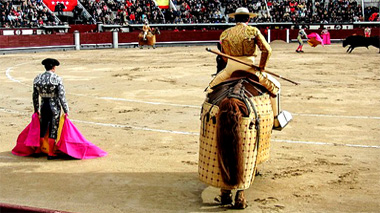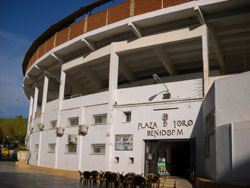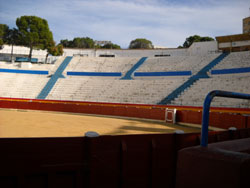Two things are most often associated with Spanish culture abroad: Flamenco and bullfighting. Bullfighting is considered to be the second most important sport in Spain after football, which is the only sport in which bullfighting is controversial. Animal rights activists all over the world protest and demonstrate against the Corrida de Toros (bullfighting). In Spain, the issue is not quite as important, but recent surveys show that a clear majority of the population is no longer a friend of bullfighting. On the other hand, there is of course a large group of fans and fanatics.
Season is in summer, in most bullring about from May to September. In some arenas the season starts earlier (in Madrid in February). Bullfights often take place on weekends – in some arenas only a few times a year, in others more often.
There are often bullfighting events during city festivals (fiestas). The entrance fees for bullfights in Spain are between 20 and 100 Euros. The entrance fee depends strongly on the rank (back or front) as well as sun or shade (shade is, how should it be different in Spain in summer, much cheaper).

For the Spanish, bullfighting is both sport and art (La Lidia). A fight rarely lasts longer than 30 minutes and usually ends with the death of the bull. First the bull is made aggressive with lances and spears with barbs, which are rammed into the neck of the animal. This is followed by the great and famous appearance of the matador (the main human figure in bullfighting) with the red cloth (maleta). After a few more minutes the matador kills the bull with a single dagger blow, which usually kills the animal immediately – at least if the 500 kg or more heavy bull has not injured or killed the matador beforehand (which happens rather rarely).
By the way, the story of the aggressive red colour of the cloth at the bullfight is a legend. Today we know that bulls are colorblind and are not irritated by the red, but only by the movements of the cloth. There are bullfights in whole Spain (mostly in big cities), but the bulls almost always come from southern Spain (Andalusia). The fights always take place in a bullring (Plaza de Toros), which are round.


The best known bullfighting arenas in Spain are in Madrid (Las Ventas) and Seville (La Maestranza). Besides Spain, bullfights are also held in Latin America, Portugal and France. However, nowhere is bullfighting more important than in the home country. In the tourist areas there are often bullfighting demonstrations for foreign tourists, which are not identical with the real bullfighting.
Another tradition in Spain is bull driving. The most famous is the encierros in Pamplona. Once a year the bulls are chased through the narrow streets of the old town. There were several serious and fatal accidents with spectators and participants. Hemingway’s novel “Fiesta” made the bull run of Pamplona world famous. By the way, the writer was also a great lover of bullfighting.
In recent years more and more people have been calling for a ban on bullfighting in Spain. The population and politics are deeply divided. In Catalonia, including Barcelona, the organisation of bullfights has been banned since 2012. In other parts of the country, however, there are still events. Television broadcasting is also controversial, especially live transmissions during the day when children are watching. Critics consider the senseless death of cattle to be more than senseless. These were restricted, but never stopped completely. The oldest and best-known stadium for the fight with the bulls is the Arena of Ronda, in the very south of the Iberian Peninsula.
More travel guides: E-Bike Florence – London Zoo Tickets – Knossos Tickets
|
Our tips: Prepare good websites for holidays in Spain for the 2025 season |
|||
|